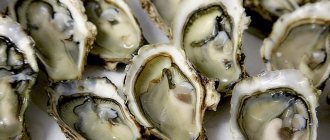Meat, fish, poultry
Although these mollusks are the closest relatives of mussels, they are many times more expensive. How to store oysters that were bought for future use and preserve their unique taste, which only gourmets can appreciate, until serving? In these days of food abundance, there is no need to go to France to taste fresh oysters; they are sold in all major supermarkets. But storing oysters after purchase is a more difficult task than selecting and serving.
The most important things about storing oysters
- On ice, oysters can be stored in the refrigerator for a maximum of 5-7 days.
- By properly freezing oysters, you can preserve them for 3-6 months.
- Re-freezing oysters is strictly prohibited.
How to choose the freshest oysters
These mollusks are classified as delicacies, as they are obtained from the sea, and such work is not cheap. Of course, the freshest oysters are those that were caught in front of you, at an oyster farm, and served with a glass of champagne and half a lemon.
It takes at least a day, maybe more, for an oyster to travel from where it was caught to the supermarket. Therefore, it would be useful to know what to look for when choosing in order to bring home a truly fresh delicacy.
It is best to buy oysters in specialized fish stores, if only because they are not considered daily consumption goods and can sit in a regular supermarket for weeks. There are general tips that will help you choose the most delicious and fresh oysters:
- the oyster shell must be closed - this is a sign that the mollusk is alive;
- the surface of the sink should be damp and have grains of sand;
- open the shell slightly - a live oyster will quickly close it;
- if the shell is slightly open, this is a sign that the oyster is not alive;
- oysters can be sold fresh and without shells, in which case they are in a container with marinade;
- if you knock the shells against each other, a sound will appear, like when tapping stones, this is a sign of living oysters;
- the most delicious shellfish are the smallest in size;
- the average size of mollusks is from 5 to 15 centimeters;
- the body of a good oyster is always transparent;
- during the active breeding season (summer), mollusks are not very tasty;
- The packaging must contain information about where the oysters were caught and when.
But since many of our sellers have long learned to deceive the buyer, you should know how to determine that an oyster has already spoiled. This is important not only from the point of view of saving money, but also because seafood poisoning is one of the most serious. For security purposes about your wallet and health, you should know:
- You should absolutely not buy oysters with their shells slightly open;
- good shellfish are not sold in containers, but exclusively on ice;
- if the body of the mollusk is cloudy or white, this is a sign of spoilage.
You can also find oysters on sale that unscrupulous sellers “helped” close again. To do this, they use a special solution that holds the doors together. You can check this like this: the surface of the sink will be dry, but if it is wet and you are not sure, it is better not to buy an expensive delicacy in markets and other untested places. Juice flows out of an already opened oyster; you can check this by weighing the shell, but the difference is insignificant and is not noticeable to the buyer.
How to choose
The time it takes this delicious product to travel from the place of catch to the store can be at least 24 hours, or even more. Therefore, when purchasing it, it is important to pay attention to some things in order to purchase a truly high-quality, fresh product.
Oysters cannot be called a product of daily consumption. Therefore, they can remain in a regular supermarket for a long time until they are sold. It is best to purchase them in specialized stores that sell only seafood.
There are several criteria that indicate a fresh, truly high-quality product.
You can buy shellfish in shells only if they are still alive. The shell doors should be closed, and the shell itself should have noticeable weight. Even if the shell is slightly open, the condition of the mollusk can be checked by lightly touching it. A live oyster will immediately close the valves. If they remain slightly open, you can no longer buy such a product.
Without shells, shellfish can be sold pickled.
There are some things to consider when purchasing:
- Smaller mollusks have the best taste, with an average size of 5 - 15 cm;
- a high-quality fresh oyster has a transparent body;
- this product must always have a description, date of catch, terms and conditions of storage;
- You cannot buy oysters with slightly open shells (without signs of life);
- good goods are sold only on ice (not in containers);
- the cloudy white body of the mollusk indicates that it is spoiled.
Sometimes unscrupulous sellers themselves close the shells with dead oysters. This also needs to be taken into account when purchasing.
How to properly store oysters
It is considered correct to buy shellfish immediately before serving, but if you will be eating oysters later, you should know how to store them after purchase. If there are grains of sand and algae left on the shells, you can clean them with an old toothbrush, but real gourmets say that it is better to serve them unwashed - this way the naturalness of the delicacy is preserved.
The best option for storing live shellfish is regular ice. Freeze ice packs for cocktails in advance and place them in a separate bowl. Place oysters on top and store in the refrigerator for 3-6 hours. Ice will not melt quickly if you set the temperature in the chamber to +2°C. If you periodically change the ice, the shelf life of oysters will increase to 5-7 days.
If you can't make ice, you can wrap the clams in a towel soaked in ice water. The period for which oysters are stored in the refrigerator in this form before serving is no more than 3 days at a temperature not exceeding +3°C.
You can also place the oysters on something frozen from the freezer, such as a piece of meat. In the refrigerator, at a temperature no higher than +5°C, the meat will defrost for a long time and you can thus store the oysters fresh and very cold for up to 2 days, after which you can make ice and continue storage using one of the methods described above.
The methods can be combined - oysters will be stored even better on ice, in a towel or frozen, as it is important to keep them as cold as possible.
All of the above methods for keeping oysters fresh are suitable for closed shellfish. Remember that a live oyster is opened immediately before consumption, and an uneaten one is not stored in the shell.
Important: You should periodically check for open shells among the oysters. No matter how correct the storage period and conditions are, it is difficult not to avoid the fact that individual mollusks may die. Storing live oysters in a bag is strictly prohibited - they must have constant access to fresh air, otherwise all the shellfish will quickly deteriorate and the shells will open. This is the most important point about how to store oysters in their shells, which should always be remembered.
Therefore, you should carefully go through all the shells and throw away the open ones. It is strictly forbidden to eat dead shellfish to avoid severe poisoning. The storage conditions for oysters cannot be changed, since they remain alive for a long time only at low temperatures. Therefore, they should be stored in only one chosen way - either in the refrigerator or in the freezer, which we will discuss below.
It is best to store oysters in the refrigerator on the top shelf, and choose the storage method yourself. Although these mollusks live in warm waters, they need to be stored fresh only at a temperature no higher than +3°C and no longer than 7 days. But another storage method cannot be ruled out.
Proper storage of oysters
It is best to buy seafood immediately before consumption. The sand and algae that often remain on the sink can be cleaned with a scrap toothbrush. But many connoisseurs of this delicacy believe that it is not worth peeling and rinsing it before serving. This gives the seafood a more natural appearance.
The best way to store live oysters is on ice. To do this, water is frozen using special bags. Then put the resulting ice in a deep container, place shellfish on top of it, and store them on the refrigerator shelf for 3 - 6 hours.
If you set the temperature in the refrigerator no higher than +2 ° C, the ice will not melt too quickly. And if it is periodically replaced with a new one, the shelf life of oysters in such conditions can be 5 – 7 days.
When it is impossible to make ice, the seafood is wrapped in a cloth soaked in ice water. In such conditions, at +3 ° C (not higher), the shelf life of oysters in the refrigerator will be 2 - 3 days.
- It is strictly forbidden to store oysters in water: the shells will open, after which the juice will flow out and the mollusks will die.
- You also cannot keep shellfish in plastic bags and plastic containers: they will suffocate.
- During storage, the condition of the shells is constantly monitored. If any of them is open, this means that the mollusk has died. The shell is immediately thrown away, since such a product can no longer be eaten.
- Despite the fact that the natural habitat of these invertebrates is the southern seas, storing oysters at home is only possible in the cold, at +3 ° C (not higher), otherwise they will die.
The shelf life of live oysters in the refrigerator does not exceed 7 days, but there are other types of storage of this mollusk.
How to store shucked oysters
Like any other shellfish, oysters can be stored cleaned. If you are not serving them the traditional way, you can carefully remove the oysters from their shells along with their juices.
After this, you need to put them in a container and put it on ice or wrap it in a towel dipped in ice water.
The shelf life of oysters without shell is short and lasts up to 3 days.
Carefully check the appearance of the shellfish - if they turn white, it means it’s time to throw them away; eating such oysters is strictly prohibited.
However, gourmets claim that the taste deteriorates after just 6 hours, so it is better to freeze cleaned and uneaten oysters.
How to store frozen oysters
One of the popular ways to store oysters at home is freezing. After defrosting, this delicacy loses its taste, so defrosted oysters are not eaten raw. Freezing shelled oysters is easy - to do this, you need to put them on a plate and wrap the top tightly with cling film and a bag.
Store in the freezer for no longer than 30 days at temperatures from -18°С...-21°С. They should be defrosted in the refrigerator, and then checked for quality - they should all be transparent.
If you want to store closed oysters for future use, then you will need a special container with ice. Ice is poured onto the bottom, after which the shellfish are laid out and frozen.
The shelf life of oysters frozen in shells is no more than 3 months at temperatures from -18°C..-21°C. Before serving, oysters should be kept in the refrigerator until completely defrosted, at least 3 hours, and then served.
This product cannot be re-frozen.
How to store canned oysters
Like many other seafood, these shellfish are sold ready-to-eat. They taste like mussels, and you can use them in recipes in the same way as their less expensive relatives.
The terms and conditions for storing canned oysters are indicated on the can, so they must be followed strictly. The place where to properly store closed jars of oysters is a pantry or a shelf in a kitchen cabinet; the shelf life is about 6 months, at a temperature not exceeding +20°C, or as specified by the manufacturer.
It is important, after opening the tin, to transfer the oysters into a glass container and ensure that they are covered with brine.
You can also store canned oysters in the freezer; to do this, they need to be transferred to a plastic container. Store for 3 months at a temperature of 18°C...-21°C.
The period for which opened canned oysters can be stored at home is no longer than 36 hours at a temperature not exceeding +7°C.
How to store cooked oysters
Ready-made shellfish in the marinade can be stored in the refrigerator, in a glass container, for up to 7 days at a temperature no higher than +7°C. To do this, you need to boil them and put them in a clean, dry jar, pour in olive oil and close the lid tightly. This is the best way to store already cooked seafood.
Ready-made salads with oysters do not have a long shelf life, and the period for which they can be stored is up to 6 hours from the moment of preparation, at a temperature not exceeding +7°C.
See also:
Other site materials
How to store corn Well, who doesn’t love juicy corn?! It is often bought for future use and stored at home. We recommend reading the article on corn storage
How to preserve salmon The storage of red fish must be approached with complete seriousness and responsibility. We will tell you all the secrets of this process
How long does black caviar last in the refrigerator? Is there any caviar left after the holidays? This rarely happens, so it would be a shame if it gets damaged...
Comments:
Storing Cooked Oysters
In a glass container, in oil, at +7 ° C, oysters can be stored for no more than 1 week. First, they are boiled and placed in a sterile, dry jar. Then pour olive oil into it and seal it with a lid.
Salads that contain prepared seafood are stored for no more than 6 hours from the moment they are prepared, at a temperature not exceeding +7 ° C.
After purchasing, oysters should only be stored in the refrigerator. If at the same time one of them opens and acquires an unpleasant odor, it is immediately thrown away. Eating stale seafood leads to severe poisoning.










